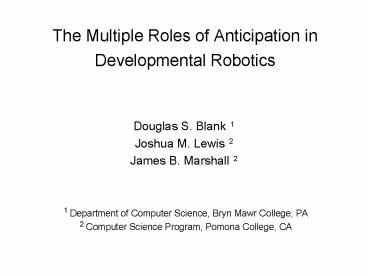The Multiple Roles of Anticipation in Developmental Robotics - PowerPoint PPT Presentation
1 / 18
Title:
The Multiple Roles of Anticipation in Developmental Robotics
Description:
1 Department of Computer Science, Bryn Mawr College, PA ... Network can learn the predictable patterns more effectively by learning to ... – PowerPoint PPT presentation
Number of Views:21
Avg rating:3.0/5.0
Title: The Multiple Roles of Anticipation in Developmental Robotics
1
The Multiple Roles of Anticipation
inDevelopmental Robotics
- Douglas S. Blank 1
- Joshua M. Lewis 2
- James B. Marshall 2
- 1 Department of Computer Science, Bryn Mawr
College, PA - 2 Computer Science Program, Pomona College, CA
2
Uses of Anticipation
- Bootstrap learning of sensorimotor maps
- Work by Pierce and Kuipers (1997)
- Robot starts with uninterpreted sensory data and
no knowledge of its own sensor types - Analyzes correlations observed in sensory stream
- Learns to anticipate the effects of its motor
commands on sensory features - Develops a model of its own sensorimotor topology
and the environment
3
Uses of Anticipation
- Source of internal reinforcement signals
- Work by Marshall, Blank, and Meeden (2004)
- Robot controlled by Simple Recurrent Network
- SRN generates next motor action and predicts next
visual state - Prediction error used to generate a reinforcement
signal for training SRN using Complementary
Reinforcement Backprop - Robot learns to visually track a moving decoy
4
Uses of Anticipation
- Learning to distinguish learnable from
unlearnable patterns with a neural net - Some input patterns are inherently
predictableInput 0 0 1 0 Target 0 1 - Some inputs are notInput 1 1 1 0 Target
random bits - Network can learn the predictable patterns more
effectively by learning to anticipate its own
errors and its own internal representations
5
Anticipation as a Learning Accelerator
- Curious developing robots are vulnerable to
fixating on random aspects of their environment. - How can we encourage the robot to discover that
some parts of its environment are unlearnable? - Anticipation plays a key role in our attempts at
this kind of learning enhancement.
6
Problem Space
- Double XOR problem
- 0 75 noisy patterns
- Two flag bits at beginning of input indicate
whether training sample is predictable
7
Network Architecture
- Standard three-layer backpropagation network with
the output layer split into several components - Utilizes two independent learning techniques
Error Anticipation and Hidden Layer Anticipation
8
Error Anticipation
- Attempts to predict the error vector of another
component of the output layer. - Helped most when a large portion of the training
set was noisy.
9
Hidden Layer Anticipation
- Attempts to predict the activation values of the
hidden layer for the current training sample. - Always provides a boost to learning, but most
significantly in the presence of random data.
10
Experiment Design
- Compared several networks
- Standard backpropagation
- Error Anticipation only
- Hidden Layer Anticipation only
- Combined EAHLA
- 10 trials of 1200 epochs for each network.
- Targeted EA and HLA components to .5 if not in
use. Network structure was kept the same.
11
Results 0 Noisy Patterns
12
Results 25 Noisy Patterns
13
Results 50 Noisy Patterns
14
Results 75 Noisy Patterns
15
Why Does Error Anticipation Work?
- We believe that error anticipation helps the
network segregate random and deterministic
training samples in the network's hidden layer
representation. - Os are random, Xs are deterministic
16
Why Does Hidden Layer Anticipation Work?
- In general we believe that HLA reinforces the
path that learning was initially taking. - As the desired problem is learned, the error from
deterministic samples decreases and the random
samples gain more weight.
17
Follow Up Experiment
- No flag bits
- Same input and output size as XOR problem
- Promising results at 75 noise
18
Conclusions and Future Work
- EA can help learning, but only if noise is
present. - HLA assists learning to a greater degree, most
notably in environments with noise. - Train networks on temporal XOR problems using
recurrent networks with EA and HLA. - Apply techniques to networks in simulated and
real robotic environments.































